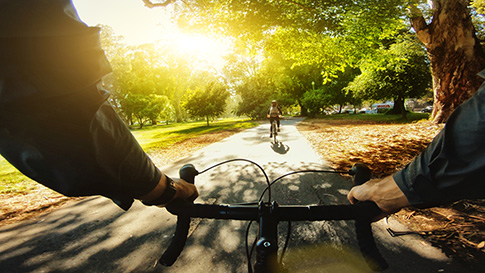Cycling and the Highway Safety Code: What you need to know

The Highway Safety Code (HSC) was significantly revamped in 2018, and the changes affect cyclists in particular. Here’s what they need to remember when they get on their bikes:
- Cyclists may ride on a sidewalk if necessary or where directed or authorized to do so by a sign or signal.
- Cyclists must obey all traffic signs and signals, including stop signs, even if the way is clear.
- Cyclists must stop at least five metres from a school bus when its red lights are flashing.
- Cyclists must ride as close as possible to the edge or right side of the roadway.
- Vehicles must maintain a safe distance of 1.5 meters when passing bicycles and pedestrians on roads where the speed limit is more than 50 km/h, and 1 meter on roads where the speed limit is 50 km/h or less.
- Drinking alcoholic beverages while riding a bicycle is prohibited (fine of $80 to $100).
What does the HSC say about e-bikes?
The Highway Safety Code applies to all cyclists, but there are additional rules for e-bike riders. For example, helmets are mandatory at any age, or you could face a fine of $60 to $100 plus costs. You must be at least 14 years old to operate an e-bike and have a Class 6D (motorcycle) licence if you are 17 or younger. If you are 18 or over, you don’t need a licence to ride an e-bike.
E-bikes are generally allowed on bike paths, unless they have running boards. Because bike paths are available to a variety of users, e-bikers must ride cautiously and be aware of their surroundings.
Higher fines for cyclists
Fines handed out to cyclists have tripled, up to $100 (plus fees) regardless of the offence or the type of bicycle (e.g., electric bicycle). However, demerit points are no longer added to your driving record. Visit the Société de l’assurance automobile du Québec website for more information.
Pedestrian and bicycle traffic lights
Prior to 2018, cyclists could cross an intersection at the same time as pedestrians when the pedestrian light was green, as long as they walked their bikes. Things have changed since the HSC was revised. Cyclists can now stay on their bikes and ride “at a safe, reasonable speed” after stopping and yielding to pedestrians.
Sharing the road and protecting the most vulnerable

The “cars vs. bicycles” war that sometimes breaks out at intersections has been compounded by a “bicycles vs. pedestrians” war, and the burden of caution falls on cyclists and motorists. Everyone must remain alert to pedestrians, even the ones who jaywalk or have their noses glued to their cellphones! Basically, it’s all about sharing the road.
Reflectors and headlights: The essentials on your bike
Did you know that you have to have at least six reflectors on your bike, whether it’s electric or not? Under the revised HSC, these reflectors can be reflective strips on tires, rims, or even your bike shoes. A white headlight and a red tail light are also mandatory for riding in the dark. CAA-Quebec recommends installing active lights (battery-operated, dynamo, or induction) to make sure you can see and be seen.
How to ride into an intersection with a right turn lane
Prior to 2018, riding a bicycle between two rows of vehicles was prohibited under the HSC. It is now allowed, but only when a cyclist wants to go straight at an intersection with a right turn lane.
Cyclists can leave the right side of the road and cautiously ride to the left of vehicles waiting to turn right and with traffic also going straight ahead.
To prevent cyclists from feeling squeezed in, some cities have designated bike lanes. These “bike boxes” let cyclists get ahead of general traffic and be clearly visible while waiting for the light to turn green.
Protection for safe cycling
If you’re a CAA-Quebec member and have an incident with your bicycle, you can call Bike Assist. For peace of mind, it’s also worth knowing some basic principles about insurance and bicycles.

Benefit from personalized advice
Do you have questions about gas-powered or electric vehicles, driving, or need recommendations to find an Approved Auto Repair Service?